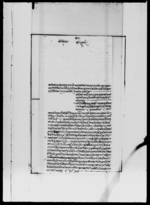A rukkā from Bīra Śamśera to the officers of Rautahat and Sarlahi districts ordering the provision of sacrificial animals for Dasaĩ (VS 1956)
ID: E_2782_0009
Edited and
translated by Astrid Zotter
in collaboration with
Ramhari Timalsina
Created: 2016-09-21;
Last modified: 2018-06-22
For the metadata of the document, click here
The accompanying edition, translation/synopsis and/or commentary are available under the terms of the Creative Commons Attribution-ShareAlike 4.0 International License
Abstract
Referring to the usual practice, this executive order (rukkā) of Premier Bīra Śamśera Jaṅga Rāṇā, countersigned by C-in-C Deva Śamśera, orders the officers of the revenue offices of Rautahat and Sarlahi to buy and send male buffaloes and he-goats for the sacrifices on the occasion of the Baḍādasaĩ rituals performed on behalf of the state.Diplomatic edition
[1r]
श्री•\1श्रीदेवदेवता2२1श्री५सर्कार
2१1स्वस्तिश्रीमदतिप्रचण्डभुजदण्डेत्यादीश्रीश्रीश्री•महाराजवीरसम्सेरजङ्गराणाव
2हादुरजिसियेसआईथोङ्लीङ्पिम्माकोकाङ्वाङ्स्यान्पृअगोदवापृ•अगोप्रप•
3प्राईममिनीष्टरयाण्डकम्यांडरईनचीफकस्यरुक्का¯¯¯¯¯¯¯¯¯¯¯¯¯¯¯¯¯¯¯¯¯¯
4स्वस्तिश्रीमदजिकुमारकुमारात्मजश्रीकम्यां
5डरईनचीफजनरलदेवसम्सेरजङ्गराणावहादुर•
6कस्यपत्रम्•¯¯¯¯¯¯¯¯¯¯¯¯¯¯¯¯¯¯¯¯¯¯
7आगेजिल्लैरौतहट्सर्लाहीमालकाहाकीम्का
8रींदाकेयथोचीत्उप्रांतसावीकदेषीतोसाषा
9नारकमवाट¯ ¯१¯कावडादसैमा¯ ¯२¯कापु
10जालाईभोगवलीकेजिल्लैरौतहट्सर्लाहीवारापर्साजील्ला४वाटजील्ला१कोरा
11गा गोटा७५वोकागोटा१०१कादरले•रागागोटा३००वोकागोटा४०४ज्मागोटा७०४ष
12रिदभैआई¯ ¯१¯कावडादसैकोकाम्चलीआयाकोछयोसालकावडादसैकोका
13मलाईपनीसावीकवमोजीम्रागागोटा१कोमोहर्रु५वोकागोटागोटा१कोमोहर्रु
14१।• मानवढाईभरसककीफायेतगरीजिल्ला१कोरागागोटा७५वोकागोटा१०१काही
15सावलेतेसजील्ला२कोरागागोटा१५०वोकागोटा२०२ज्मा३५२सावीकमातेसजी
16ल्लाकोचौधरीजीमीदारअदालत्थानापुलीसजसजसलाईसाछीराषीषरिदभया
17कोछसोमानीससाछीराषीतेसजील्लाकोआम्दानीमध्येसुपतमोलदीषरिदगरि•
18आश्वीनसुदी३।४रोजसम्ममायाहाआईपुग्नेगरीपठाईदीनुसोरागावोकाषरिद
19भयाकोकचाव़ारिपरलमोलरचरुवाहीघासपरालस्मेत्षर्चस्मेत्कौसीतोसाषाना
20वाटभर्नालीनुसोरागावोकाषरिदकोपरलमोलषर्चकोकागजपनीरागावोकाच
21लानगर्याकैदीनुचलान्गर्नुसोरागावोकाषरिदकोपरलषर्चकोकागजनआईत्या
22हाअड्काउभैजरिवानाहुनगयोभन्यातिमीहरुलेचुगाउनुपर्लाभंन्यावेहोराकोजी
23ल्लैरौतहट्•सर्लाहीमालकाहाकीम्कारिंदाकानाउमारुक्कादस्षत्गरिवक्सनुप
24र्नेमानीस्वंदोवस्तषारेजभयाकोरसावीक्चलीआयाकोहुनालेसावीक्चली
25आयावमोजीम्ठहराञाभनीकौसीतोसाषानाकाहाकीम्कारिंदालेहाम्राहजुरमा
26विंतीपार्दाजाहेरभयोतसर्थसोठहरायावमोजीम्हामीवाटपनीसदरगरिवक्स्या
27कोछसोवमोजीम्गर्न्याकाम्गरभंन्यारुक्कादस्षत्गरिवक्स्यौंईतिसम्वत्१९५६
28साल्मीतीश्रावसु दी रोज शुभ्म्¯¯¯¯¯¯¯¯¯¯¯¯¯¯¯¯¯¯¯¯¯¯
Translation
[1r]
Venerable deities
2
1
Hail! An executive order (rukkā) of him who is illustrious, very mighty and has arms like a staff etc., the thrice venerable great king Bīra Śamśera Jaṅga Rāṇā, the brave, GCSI,1 thoṅ-līṅ-pim-mā-ko-kāṅ-vāṅ-syān,2 pṛ. agoda. bā. pṛ. ago. prapa.,3 prime minister and commander-in-chief.
Hail! A letter of the illustrious prince, son of a prince, the venerable commander-in-chief General Deva Śamśera Jaṅga Rāṇā, the brave.
To the chief officers (hākima) and clerks of the revenue offices (māla) of the districts (jillā) Rautahat and Sarlahi.
[Regarding] the following (yathocītuprānta): Since earlier times, 300 head of male buffaloes and 404 head of he-goats, altogether 704 head [of cattle], have been brought from the four districts Rautahat, Sarlahi, Bara and Parsa as sacrificial animals (bhogabalike) for the worship of [different deities]4 in the Baḍādasaĩ [rituals carried out on behalf] of [Śrī 5 Sarkāra],5 after being bought with monies from the treasury (tosākhānārakamabāṭa) at the rate of 75 head of male buffaloes and 101 head of he-goats from each district, [and with these] the rituals of the Baḍādasaĩ of [Śrī 5 Sarkāra] have customarily been performed. For the rituals of this year's Baḍādasaĩ, too, as in the past, save as much [money] as possible, not exceeding 5 mohara rupaiyā per head of male buffalo and 1 mohara rupaiyā, 1 [sukā] per head of he-goat—from these two districts, at 75 head of male buffaloes and 101 head of he-goats per district, 150 head of male buffaloes and 202 head of he-goats, altogether 352 head [of cattle]. Appoint as supervisor (sāchī) the [type of] person who in the past was supervisor [when] the purchase was made—a jimidāra of these districts, [or] anybody [from] a court (adālat), military post (thānā) [or] police. Pay an appropriate price with income from the districts and send [the animals] so as to arrive here by the 3rd or 4th of the bright half of the month of Āśvina. Take reimbursement from the Kausī Tosākhānā for the actual price paid [according to] the financial details (kacāvāri for kaccāvārī) [recorded] when buying these male buffaloes and he-goats, together with the expenses for the herders (caruvāhī), grass and rice straw. Give the document [specifying] the price and [other] expenses actually incurred when buying these male buffaloes and he-goats to the persons who drive the buffaloes and goats, too. [Have them] carry out the drive [here]. It has come to our notice through the chief officer and clerks of the Kausī Tosākhānā filing a petition stating: "[The arrangement for procuring sacrificial animals] has been fixed in accordance with what has been the usual practice including that, as usual, a signed executive order (rukkā) requesting the [financial] details should be addressed to the chief officers and clerks of the revenue offices of Rautahat and Sarlahi districts, stating that in case the document [containing] the actual expenses [incurred in] the purchase of these male buffaloes and he-goats does not arrive [here or] is held up there, [or else] is made subject to fines, [they—that is,] you—will have to make up the loss (cugāunu for cukāunu)." Therefore: What is in accordance with what has been fixed has also been endorsed by us. We have [herewith] signed an executive order (rukkā) stating: "Carry out the task of acting accordingly."
…day, the … of the bright fortnight of the month of Śrāvaṇa of the [Vikrama] era year 1956 (1899 CE). Auspiciousness.
Commentary
In this document, the distinctions between similar akṣaras are often hard to pin down. This applies especially when it comes to deciding whether the scribe intended to write ri or rī. The document is not only scribed roughly, it also sometimes displays significant corrections pertaining to content. As deletions such as caudharī in l. 16 or the phrase mānīsa baṃdobasta khāreja bhayāko ra in l. 24 are unlikely to be present if this were a copy of an original document; moreover, as the actual lunar day and weekday, and the space for attaching the seal of the issuer, Deva Śamśera Rāṇā, have been left blank, I feel inclined to assume that this is the draft of an executive order, subsequently to be prepared, dated and sealed only after a clean copy of it was made. This hypothesis can only be confirmed if either the issued document or, alternatively, a similar draft is found.

